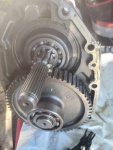Yep, you won't know until you get in there.
Part 150 (Fig. 1) comes from the spider gears in the differential and drives the part 40 gear (Fig. 3).
Brake clutches, in Fig. 2 (part 60), stops that from spinning which will send power to the other wheel.
Stripped teeth on the part 150 (Fig.1) that contacts part 40 gear (Fig. 3), or the teeth on that part 40 gear (Fig. 3), or the internal splines on the part 40 gear (Fig. 3), or the splines on the axle itself (Part 10, Fig. 3), could all cause the problem you are having.
If the two bearings, parts 30 and 60 (Fig. 3) are pressed onto the axle, I could see how the axle could break and not fall out. But, like I mentioned earlier, the .pdf didn't state the bearings needed to be pressed off.
Part 150 (Fig. 1) comes from the spider gears in the differential and drives the part 40 gear (Fig. 3).
Brake clutches, in Fig. 2 (part 60), stops that from spinning which will send power to the other wheel.
Stripped teeth on the part 150 (Fig.1) that contacts part 40 gear (Fig. 3), or the teeth on that part 40 gear (Fig. 3), or the internal splines on the part 40 gear (Fig. 3), or the splines on the axle itself (Part 10, Fig. 3), could all cause the problem you are having.
If the two bearings, parts 30 and 60 (Fig. 3) are pressed onto the axle, I could see how the axle could break and not fall out. But, like I mentioned earlier, the .pdf didn't state the bearings needed to be pressed off.


